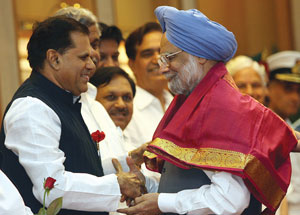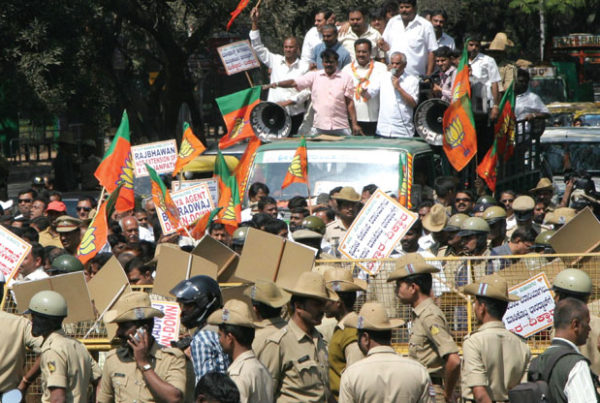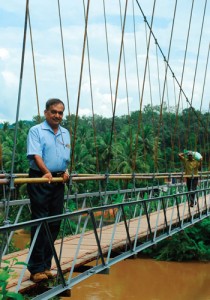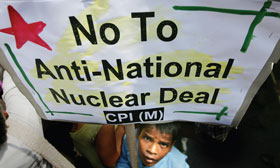 The noes The CPM was the first party to object to the India-US nuclear agreement. It quit the UPA on this issue
The noes The CPM was the first party to object to the India-US nuclear agreement. It quit the UPA on this issue WHEN CONGRESS president Sonia Gandhi, in her recent address to the Congress Parliamentary Party, acknowledged “inadequacies” in dealing with the Bhopal gas tragedy, it made headlines.The collective gasp as the country heard her proclaim — “We cannot remain prisoners of the past. We must look ahead and answer the question – what can we do now, rather than, what could we have done in the past,” — was a very audible one. Twenty-six years after the world’s worst industrial disaster, could her words mean that hope was round the corner for the Bhopalis? Would it mean that as a country we would work to ensure we have no more Bhopals?
WHEN CONGRESS president Sonia Gandhi, in her recent address to the Congress Parliamentary Party, acknowledged “inadequacies” in dealing with the Bhopal gas tragedy, it made headlines.The collective gasp as the country heard her proclaim — “We cannot remain prisoners of the past. We must look ahead and answer the question – what can we do now, rather than, what could we have done in the past,” — was a very audible one. Twenty-six years after the world’s worst industrial disaster, could her words mean that hope was round the corner for the Bhopalis? Would it mean that as a country we would work to ensure we have no more Bhopals?
But, a day after her statement, Gandhi and her legislators were back at work — attempting to get the nuclear liability draft legislation passed in Parliament. If government officials and activists are to be believed, the legislation could potentially protect the Warren Andersons and Dow Chemicals of the nuclear industry. As this story goes to press, negotiations between political parties were still underway with likely indications that the draft legislation would pass through the Parliament.
The Civil Liability for Nuclear Damage Bill (2010) or the Nuclear Liability Bill as it is frequently referred to, is a complex piece of legislation that was first introduced in the Lok Sabha on 7 May 2010. It seeks to define nuclear damage, nuclear installations and its operators. Also significantly, the bill seeks to define who will be liable for nuclear damage and the financial limits to the liability besides creating struc-tures for assessments of claims since its principal intent is to “provide prompt compensation to the victims of a nuclear incident or accident”. As TEHELKA found out, a closer look shows there is enough to doubt this stated intention.
Following vociferous objections by the opposition, the legislation was referred to Parliament’s Standing Committee on Science and Technology, Environment and Forests. It was the government’s effort at achieving consensus — an effort that is however mired in controversy. The draft as well as the working of the Standing Committee has been criticised for compromising the interests of the people in favour of the nuclear industry.
Why is the legislation important? At a time when India is looking to rapidly ramp up its nuclear energy production from the current estimated 4,560 MW to a massive 63,000 MW by 2032, enacting the legislation is seen as the first step towards achieving this target. India has 19 reactors operational and plans to build another 25-30 reactors.
BESIDES INCREASED production, the legislation also signals a massive direction change in India’s nuclear energy programme. Traditionally, India’s nuclear energy programme has been entirely in the public sector. Various government corporations such as the Uranium Corporation of India Limited, Indian Rare Earths Limited (agencies responsible for mining radioactive materials to feed the nuclear reactors) to the Nuclear Power Corporation of India Limited (responsible for nuclear plant operations) drive the implementation end. The technology required to build reactors has, for the most part, been developed in public sector research organisations such as the Bhabha Atomic Research Centre in Mumbai. The Department of Atomic Energy (DAE) — a ministry under the direct charge of the Prime Minister — oversees the functioning of these public sector corporations.
The Health Ministry told a Parliamentary Committee they were nowhere ready to deal with a nuclear emergency
All this is however set to change rapidly. The Indo-US agreement signed in July 2005 as well as the India-specific waiver that was granted by the influential Nuclear Suppliers Group in July 2006 paved the way for the opening up of the sector to private players. India already has negotiated agreements with the governments of Russia and France, allowing for Russian and French companies to participate in India’s nuclear energy programme. Significantly, India’s agreement with France in February 2009 allowed India to reprocess nuclear waste generated through the energy production programme and use it for its nuclear weapons programme.
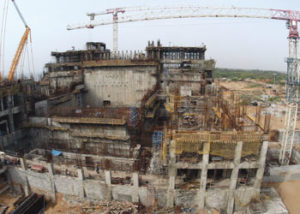
Nuke reactor: This is the Kalpakkam reactor, which is slated to begin commercial production of N-power in 2011
But for India to allow private players like US-based Westinghouse, General Electric and a host of others to supply nuclear fuel and equipment, the nuclear liability legislation becomes absolutely crucial since it will specify whether these players can be held responsible for damages in case of nuclear accidents. Additionally, in September 2008, India gave a formal assurance to the US government that it would sign the Convention for Supplementary Compensation (CSC) for Nuclear Damage that is promoted by the International Atomic Energy Agency — the international organisation that promotes and regulates nuclear programmes of different countries.
But a close reading of the CSC reveals the extensive protection it accords to nuclear suppliers, indemnifying them completely in case of nuclear accidents. A top-ranking DAE official, speaking on condition of anonymity, told TEHELKA the liability bill was “necessary” if India was to sign the CSC. Citing Article 3.3 of the CSC, which says “the liability of the operator for nuclear damage shall be absolute…”, the official talked of how the Indian Atomic Energy Act 1962 stipulated that the operators of nuclear plants should be government owned or controlled entities. Since amendments to the Act were not on the anvil, signing the CSC convention would then ensure that the liability charge in case of nuclear accidents would shift back to the government — instead of the private suppliers. “Having committed to joining the CSC in September 2008, this government is under significant pressure to ensure that the legislation is passed. This is the pressure of the nuclear industry that wants a slice of India’s multi-billion dollar nuclear energy business. By succumbing to that pressure, we are making many more Bhopals possible,” he said.
There is further evidence to suggest industry collusion and pressure. Activists from Greenpeace, Toxics Watch and senior commentators writing on the subject told TEHELKA that the DAE drafted the nuclear liability bill based on a 57-page Federation of Indian Chambers of Commerce and Industry (FICCI) report. The 25-member FICCI group that drafted the report was led by SK Jain, chairman and managing director of NPCIL, the government undertaking in charge of operations at all 19 nuclear plants in India. Jain refused several attempts at clarification by TEHELKA. But the pressure from the industry didn’t end there.
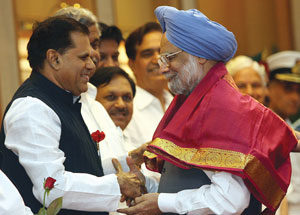
For the PM Subbarami Reddy (left) heads an important parliamentary committee on science, where nuclear issues go to
In a letter dated 13 July 2010, a copy of which is with TEHELKA, Rajesh Menon, senior director of the CII, wrote to T Subbarami Reddy, the chairman of the Standing Committee, asking for specific changes in the legislation. It was a forceful submission — “In order that the Indian industry can even participate in the nuclear industry and trade calls for the following changes in the draft nuclear legislation, in entirety…”. The CII wanted a modification of Article 46 “to channel all liability to the operator of a nuclear power plant”. Further, they asked for an inclusion to read: “This law shall be the sole and exclusive remedy for all nuclear damage claims.” And significantly, deletion of clause 17 (b).
About a month before the CII letter to the Standing Committee chairman, the Committee had called for a meeting to hear the representatives of FICCI, CII and ASSOCHAM. The meeting records accessed by TEHELKA show the Committee met with industry representatives on 15 May in the second sitting of the Committee, the first one was with the DAE secretary. Also, the meeting with the industry representatives took place before a crucial 5 August round with stakeholder ministries such as the Ministry of Health and Family Welfare, and the Ministry of Environment and Forests — the ministries that would need to act in case of a nuclear accident. In what must be acknowledged as a credit to the Standing Committee, only one of the CII’s suggestions were taken on board — the contentious clause 17 (b), which provides recourse to suppliers. On 25 August, the Lok Sabha passed the Nuclear Liability Bill with 18 amendments.
Between 1999 and 2009, there have been 13 accidents in Indian nuclear facilities. Our record is poor and worrisome.
IN THE final analysis, what is disturbing is the short shrift given to assertions by officials in the ministries of water resources, health and environment, which will be responsible for managing situations in the eventuality of a nuclear accident — that their opinions were not considered before the legislation was drafted. Consider this, even as there is vocal opposition about the final liability amount, the Environment Ministry official revealed to the Standing Committee that there had been no attempt to even define the scope of what constitutes environment — an integral requirement if environmental damage was under discussion for assessment in case of disaster. Even more disturbingly, the Health Ministry official told the Committee that her ministry is “nowhere [ready] to meet an eventuality that may arise out of nuclear and radiological emergencies”. Further, a poor response system and ill-equipped hospitals would only ensure that “mortality and morbidity… could be on a very high scale”. In fact, for a legislation that claims to focus on payment of compensation due to health impacts of radiation, there isn’t a single clause that details diseases or health care!
India’s track record of nuclear accidents or incidents is barely a clean one. Between 1999 and 2009, there have been 13 accidents at various nuclear facilities — a figure that may well be inaccurate since there is no document in the public domain — the list of 13 accidents have been pieced together by various DAE statements and reports over the years. As we move towards a rapid opening up of the nuclear power sector, the words that come back to haunt are those of Sonia Gandhi. Will we remain prisoners of the past? Can we truthfully say we are doing all we can now? That we will not have occasion to revisit the inadequacies we speak of when we remember Bhopal?
—
This article was originally published in Tehelka, a leading independent news magazine in India, known for its investigative journalism.
